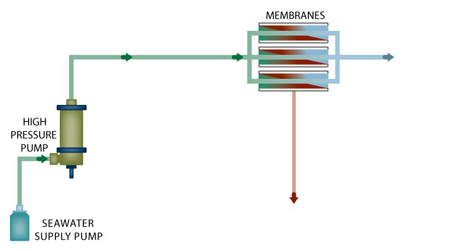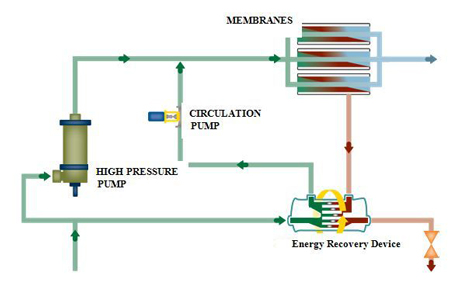Breaking ground in desalination performance and energy efficiency with high-pressure pump innovation.
According to recent statistics from the International Desalination Association (IDA), growth in desalination is increasing dramatically, with more than 14,451 plants worldwide, up from 13,751 in 2008. The primary technology used continues to be reverse osmosis (RO), a process proven to be a viable solution to water scarcity—a problem more countries face every year.Reducing the energy consumption required by the RO process to keep down costs offers more sustainable plant practices and continues to deliver clean, affordable water. It is critical to every original equipment manufacturer (OEM) and engineering, procurement and construction contractor (EPC). Reaching these goals can only be accomplished within safe, predictable and trouble-free operations.
Improving current multistage centrifugal pump technology is the next step in reducing energy usage and increasing pump performance to ensure lowered operating costs and expedited return on investment for providing safe, affordable desalinated water.
The Role of High Pressure Pumps in Desalination Systems
The high pressure pump is the heart of the desalination process—every desalination plant must have at least one high pressure pump. In plants with multiple trains, which are modular desalination units that consist of membranes, pumps, energy recovery devices, etc., each train also typically has a high pressure pump. The trains typically share common piping headers and may share common system pretreatment.

Figure 1. Typical reverse osmosis diagram with high pressure pump
In the early days of desalination, positive displacement (PD) pumps were common. PD pumps offered higher efficiencies than early centrifugal pumps when desalination
plant sizes were relatively small.
As desalination matured, however, users began to realize the limitations of positive displacement pumps to scale to larger facilities and began to adopt centrifugal pumps due to their inherently easier operation, maintenance and scalability to larger capacities. Positive displacement pumps still have a place in desalination but are typically found in smaller train sizes that generate less than 100 gallons per minute (gpm).
Centrifugal Pump Technological Advances and Designs
Centrifugal pump efficiencies have continued to increase due to technological innovations. One key innovation is the use of computational fluid dynamics (CFD) software to optimize the hydraulic component design. The use of this highly complex software allows pump manufacturers to precisely model the entire hydraulic space of the pump and reduce efficiency losses internally.
The hydraulic designer has the ability to see how the flow of water will react to changes in blade geometry without having to build a prototype for every new design. Of course, all designs are fully tested during the BETA testing phase of the project.
Another key component of high pressure pump design is how the pump handles thrust loads. Thrust loads can be handled in multiple ways. Some are more effective than others.
Some pumps rely on the motor bearing to handle the thrust load, though this configuration is not common, as the motor bearing is not designed to handle the high loads imposed by the desalination process.
Other systems have an external bearing system located between the pump and motor to handle the thrust. These external bearing systems require oil and/or grease lubrication
to function properly, as well as regular maintenance and instrumentation to ensure proper operation.
In other systems, an internal disc-type thrust bearing inside the pump eliminates external bearing systems but relies on a pressure differential to function properly. This pressure
differential can only be accomplished via external tubing from the bearing location (high-pressure side) back to the pump suction (low-pressure side), which is subject to damage, corrosion, breaking, etc.
The most ideal design employs an internal hydrodynamic thrust bearing that does not require external tubing and is lubricated by the pumped fluid. In this system, the bearing uses a series of tilting pads and an adjacent rotating impeller. When the pump is started, a fluid film is instantaneously established.

Figure 2. Reverse osmosis process diagram with energy recovery device.
As the impeller comes up to speed, the fluid layer between the surfaces of the pads and impeller is compressed, forcing the pads to come to an equilibrium point and run parallel to the impeller face. Once this compressed fluid layer has a resistive force equal to that of the thrust load, the pump has reached its normal operating point.
The hydrodynamic fluid bearing was designed specifically for desalination and, therefore, is capable of handling tremendous thrust loads. The bearing arrangement is ideal as it is completely contained within the pump and requires no external ancillary equipment.
This bearing has no scheduled maintenance because there is no mechanical contact with the pump internals. All internal sleeves, radial bearings, etc., are also fluid lubricated making this the first horizontal multistage centrifugal pump of its kind in the desalination industry.
Increasing Efficiency in Desalination Systems: the Role of Energy Recovery Devices
As desalination becomes more widely adopted across the world, energy consumption has become a hot button issue. Desalination, and reverse osmosis (RO) in particular, are energy intensive processes, with energy accounting for approximately 50 percent of a typical desalination plant's annual operating expenditures. For this reason, maximizing pump efficiency is critical to the viability of desalination as an economical solution to fresh water shortages.
In addition to using high efficiency pumps, energy recovery devices (ERDs) have gained popularity because they reduce the energy used in desalination systems and reduce costs. There are many ERDs available, and like pumps, ERDs can be broken down into isobaric (similar to positive displacement) and centrifugal devices. Isobaric devices typically have a higher efficiency but are more complex and may require ancillary equipment.
| Flow | 2000gpm |
| Differential Pressure | 900psi |
| Cost of energy | $0.10/KWh |
| Traditional Pump Efficiency | 83% |
| Tiliting Pad Pump Efficiency | 85% |
| Motor Efficiency | 95% |
| Traditional Pump Required Power | 1331.11 HP |
| Tilting Pad Pump Required Power | 1299.79 HP |
| Cost Savings per year | $20,467.64 |
Table 1. Cost savings with hydro-dynamic thrust bearing pumps.
Centrifugal devices are typically less efficient but are simpler to use and install in the system. Both of these types of ERDs capture and recycle the energy from the brine (or waste) stream of the desalination process to boost the flow on the membrane feed side.
The isobaric devices reduce the amount of flow that has to be processed by the high pressure pump, but the pump must provide full membrane pressure. The centrifugal devices reduce the required differential pressure of the high pressure pump, but the pump must provide the full feed flow.
The hydrodynamic, tilting pad style pump bearing created for desalination was also specifically designed to compliment both types of energy recovery devices. The use of these bearings combined with minimized clearances inside the pump maximizes the overall efficiency and reduces energy consumption of the overall system.
Comparisons and Conclusion
At current pump pricing, the cost savings above would pay for the pump and motor in 7 to 8 years. The table above only takes into account energy savings. The operator would realize additional savings due to the lower maintenance costs and downtime. A life cycle cost analysis should always be performed when considering high pressure pumping equipment.
Table 1 illustrates the energy cost savings from just a 2 percent gain in efficiency from using the tilting pad style bearing. When choosing a high pressure pump, one must take
into account many variables. Price and delivery should not be the only considerations. Life cycle cost analysis is the best way to determine suitability. Does the pump provide the best efficiency? What type maintenance is required and how often? Does the pump require an external bearing or external tubing? All of these questions should have significant weight in the decision-making process.
Many pump manufacturers are content with providing a traditional style pump while others continue to push the envelope and come up with new and exciting ways to improve efficiencies and help end users be successful. New pump configurations, high speed operation, new bearing designs are all waiting to be discovered.
Pumps & Systems, March 2011

